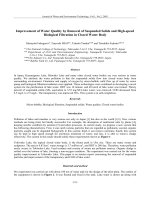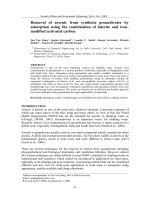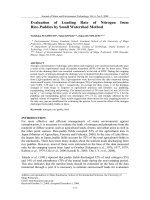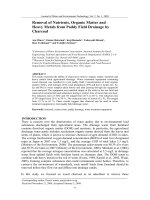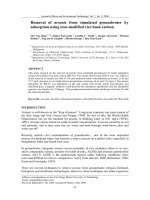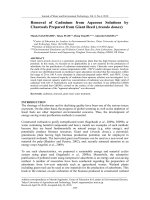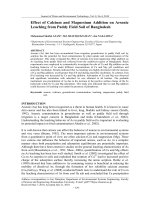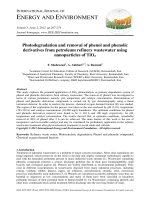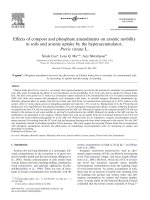Removal of arsenic from synthetic groundwater by adsorption using the combination of laterite and ironmodified activated carbon
Bạn đang xem bản rút gọn của tài liệu. Xem và tải ngay bản đầy đủ của tài liệu tại đây (897.07 KB, 12 trang )
Journal of Water and Environment Technology, Vol. 6, No.1, 2008
Removal of arsenic from synthetic groundwater by
adsorption using the combination of laterite and ironmodified activated carbon
Son Van Dang*, Junjiro Kawasaki**, Leonila C. Abella*, Joseph Auresenia*, Hiroaki
Habaki**, Pag-asa D. Gaspillo*, Hitoshi Kosuge**
* Department of Chemical Engineering, De La Salle University, 2401 Taft Avenue, 1004
Manila, Philippines
** Department of Chemical Engineering, Tokyo Institute of Technology, 2-12-1 Ookayama,
Meguro-ku, Tokyo 152-8550, Japan
ABSTRACT
Groundwater is one of the most important sources for drinking water. Arsenic (As)
contamination of groundwater is a serious problem worldwide, especially in Bangladesh, India
and South East Asia. Adsorption using appropriate and readily available adsorbents is a
promising method for the removal of arsenic with applicability in rural areas. This work aims to
study the removal of arsenic from synthetic groundwater using an adsorption column by
sequential combination of laterite (LA) and iron-modified activated carbon (AC-Fe) as
adsorbents. The effect of ratio LA/AC-Fe, flow rate, initial arsenic concentration and pH to the
breakthrough time were investigated. Adsorption equilibrium and adsorption kinetics were also
studied through batch experiment. The result was found to be an efficient and feasible approach
for arsenic treatment from groundwater for ready applicability in rural areas.
Keywords: adsorption, arsenic, breakthrough, iron-modified activated carbon, isotherm, laterite.
INTRODUCTION
Arsenic is known as one of the most toxic chemical elements. Long-term exposure of
which can cause cancer of the skin, lungs and many others. In view of this, the World
Health Organization (WHO) has set the standard for arsenic in drinking water as
0.01mg/L (WHO, 1993). Groundwater is an important source for drinking water.
Recently, arsenic (As) contamination of groundwater has become a major concern on a
global scale, especially in Bangladesh, India and South East Asia (Naidu et al., 2006).
Arsenic in groundwater usually exists as oxy-anion compound namely arsenite (trivalent
arsenic, As[III]) and arsenate (pentavalent arsenic, As[V]) where As[III] is known as the
predominant species which is more toxic and more difficult to remove than As[V]
(Amin et al., 2006).
There are several techniques for the removal of arsenic from groundwater including
physicochemical and biological treatments and membrane filtration. However, almost
all of these techniques are either difficult to meet WHO’s standard for drinking water or
sophisticated and expensive which cannot be considered in application for rural areas,
especially in developing and poor countries. A promising method that can be considered
efficient and low cost for wide-scale application in rural areas is adsorption using
appropriate, readily available and cheap adsorbents.
Address correspondence to Son Van Dang, De La Salle University,
Email:
Received April 2, 2008, Accepted July 1, 2008.
- 43 -
Journal of Water and Environment Technology, Vol. 6, No.1, 2008
Laterite (LA) is a red-colored clay existing abundantly in tropical regions. It contains
mainly compounds of iron, aluminum, and silica with positive surface charge under
normal conditions. Therefore, LA can adsorb anionic contaminants as As[III] and As[V]
(Larsson et al., 1999). A number of researchers (Larsson et al., 1999; Rupa et al., 2003;
Abhijit et al., 2007; Partey et al., 2005) have studied LA and indicated that more than
90% of As can be removed at neutral pH and Langmuir isotherm can fit with
equilibrium data. Sanjoy et al., (2007) investigated the performance of a fixed-bed
column for the removal of As[III] using laterite soil and showed that a column with 2cm
diameter and different bed heights such as 10cm, 20cm and 30cm, could produce 1.3,
7.9 and 14.88 liters of arsenic-free water, respectively, with As[III] initial concentration
of 0.5mg/L with a flow rate of 7.75mL/min.
Activated carbon (AC) is always considered as a typical adsorbent, but AC has low
arsenic removal capacity. The percentage removal of As[III] by AC is just 50%
(Prasenjit et al., 2007). However, it can be improved by its surface modification with
metals such as iron, manganese, aluminum, calcium, titanium or copper. Maximum
removal of 98% for both As[V] and As[III] can be achieved in the pH ranges of 5–7 and
9–11, respectively (Prasenjit et al., 2007; Gu et al., 2005; Gu et al., 2007). Weifang et al.
(2007) indicated that preloading AC with iron greatly improved its arsenic adsorption
capacity. When comparing rapid small-scale column tests (RSSCT) results, ironpreloaded carbon could get over 200 times longer bed life than non-modified carbon.
Although iron-modified activated carbon (AC-Fe) is known as a good adsorbent, it is
still expensive, whereas LA has been considered a cheap adsorbent. Therefore, the
sequential combination of these two adsorbents in one column, where LA is as a rough
adsorbent for cost reduction and AC-Fe is as an advanced adsorbent for further removal,
is an efficient and feasible way to remove arsenic from groundwater for ready
applicability in rural areas, especially in developing and poor countries.
This work aims to study the adsorption column for removal of arsenic from synthetic
groundwater using sequential combination of LA and AC-Fe as adsorbents. The effect
of LA/AC-Fe ratio, flow rate, initial arsenic concentration and pH to the breakthrough
time were investigated. Adsorption equilibrium and adsorption kinetics were also
studied through batch experiment.
MATERIALS AND METHODS
Synthetic groundwater
Typical groundwater with average concentration of the major components was
simulated and used in this study. The major components of the synthetic groundwater
are shown in Table 1 as referred from previous work (Lien et al., 2005).
Arsenic stock solution
The stock solutions of As(III) were prepared from As(III) standard solution of
1003mg/L (Wako Pure Chemicals Ltd, Japan). The stock solutions of As(V) were
prepared by dissolving 4.1646mg of Na2HAsO4.7H2O (Wako Pure Chemicals Ltd,
Japan) into distilled water with a total volume of 1000mL. This stock solution has an
arsenic concentration of 1000mg/L.
- 44 -
Journal of Water and Environment Technology, Vol. 6, No.1, 2008
Table 1. Composition of synthetic groundwater
Composition
Concentration, mg/L
*
CaCl2·2H2O
230
Na2SO4 *
1200
NaHCO3*
370
MgCl2·6H2O*
135
(*Wako Pure Chemicals Ltd, Japan)
Preparation of Adsorbents
Preparation of LA
In this study, laterite was collected from Ogasawa Island (Tokyo, Japan). It was sieved
to a particle size of 0.45-0.71mm. Then, LA was heated at 150oC for two hours under
anaerobic condition without washing, acidic or alkali treatment. The BET (Brunauer,
Emmett and Teller) surface area is 70.19m²/g, pore volume of 0.00062cm3/g and pore
size of 126Å.
Preparation of AC-Fe
AC from coconut shell was taken from MAPECOH, Inc (Philippines) with a particle
size of 0.45-0.71mm after sieving. Then, it was washed with distilled water, dried at
105oC for 24 hours before being modified with iron. The preparation of iron-modified
activated carbon (AC-Fe) was conducted by impregnation with 5% of iron onto AC
(theoretical calculation based on weight). The impregnation method for preparation of
AC-Fe was similar to that of Prasenjit et al. (2007). The BET (Brunauer, Emmett and
Teller) surface area was 508m²/g, pore volume was 0.2426 cm3/g, and pore size was
43.23Å.
Figure 1a and 1b showed SEM (Scan Electron Microscopy) photographs of original AC
(non-modified) and iron-modified AC, respectively. It can be seen that while the surface
of the original AC seems to be clean (Figure 1a on left side), there are some patches of
iron particles stuck on the surface of AC-Fe (Figure 1b on right side). These may be the
active sites for arsenic adsorption.
(a)
(b)
Fig.1 SEM (200x magnification) for original AC and ironmodified AC (with 5% of iron onto AC)
Experimental procedure
Batch experiment
In this study, batch experiments for equilibrium and kinetic studies were carried out in a
series of 1000mL flasks. Each of them contained 5g of adsorbents (adsorbent dose) and
- 45 -
Journal of Water and Environment Technology, Vol. 6, No.1, 2008
1000mL synthetic groundwater with various levels of total arsenic content (initial
arsenic concentration) at pH of synthetic groundwater (pH 8.18). The sample flasks
were stirred at 300rpm by speed-controlled stirrers in a temperature-controlled bath for
168h for LA and 120h for AC-Fe. These were performed under room temperature
(25oC) and atmospheric condition. The samples were taken then acidified and analyzed
for residual arsenic concentration. A mixture of 70% As[III] and 30% As[V] was used in
all of the experiments and the total arsenic content was analyzed by ICP-MS (Seiko SII).
Column experiment
Column experiments for the determination of breakthrough time were carried out in a
column of 0.025m diameter and 0.5m length. The inlet flow rate was controlled by
adjustable flow meters in up-flow mode operation. The column was divided into 2
sections: one for LA and another for AC-Fe. The parked-bed densities are 0.55m3/m3 for
LA section and 0.54m3/m3 for AC-Fe section.
The LA/AC-Fe ratio was investigated first to determine an optimum ratio, and this
optimum ratio will be fixed to investigate the effect of other parameters such as pH,
initial arsenic concentration and inlet flow rate. The samples taken were acidified and
analyzed for residual arsenic concentration. A mixture of 70% As[III] and 30% As[V]
was used in all experiments and the total arsenic content was analyzed by ICP-MS
(Seiko SII). Experimental set-up is shown in Figure 2.
8
5
3
1
7
4
2
6
1. Contaminated water tank
2. Pump
3. Flow meter
4. LA portion
5. AC-Fe portion
6. Treated water tank
7. ICP-MS
8. Computer
Figure 2 Experimental set-up
RESULTS AND DISCUSSION
Adsorption isotherm
Assuming that the adsorption/desorption process occurs in a closed batch system with
complete mixing and no mass transfer resistance, the equation is as follows:
nA + S ↔ An S
(1)
- 46 -
Journal of Water and Environment Technology, Vol. 6, No.1, 2008
This equation is written based on the adsorption site S, where A is arsenic molecule and
n is the number of arsenic molecule (n: greater than zero). The overall adsorption/desorption rate is:
dθ
= k a C An (1 − θ ) − k d
dt
(2)
in terms of adsorbate concentration q is:
dq
= k a C An (q 0 − q ) − k d q
dt
(3)
where θ is surface coverage, ka is the adsorption rate constant, L/mgs; kd is the desorption rate constant, 1/s; q is adsorbate concentration mg/g, q0 is arsenic adsorption
capacity of adsorbent, (mg/g); and CA is concentration of arsenic molecule in the
solution, mg/L. At equilibrium, from equation (3) dq/dt = 0; q = q e and CA = CA,e,, and
by derivation:
qe =
q 0 KC An,e
(4)
1 + KC An,e
where qe is adsorbate concentration at equilibrium (mg/g); CA,e is equilibrium
concentration of arsenic in solution (mg/L); and K=ka/kd is isotherm constant, (L/mg).
Equation (4) is well known as Langmuir-Freundlich isotherm. To estimate the isotherm
coefficients n, K and q0, non-linear regression method must be employed. Several
computer programs are available in dealing with nonlinear regression. In this study,
Microsoft Excel was used. The isotherm coefficients for both AC-Fe and LA are shown
in Table 2.
Results of the study showed that n is approximately one unit (Table 2). Hence, n=1 is
assumed. This means that one site of LA or AC-Fe adsorbent may adsorb one arsenic
molecule (Langmuir isotherm). Using non-linear regression method to examine
Langmuir isotherm, the value is shown in Table 3. It can be seen that Langmuir
isotherm also fits with equilibrium data for both LA and AC-Fe as shown in the values
of the regression coefficient r2. Therefore, adsorption process of arsenic onto LA and
AC-Fe may be described by Langmuir isotherm and the adsorption capacities were
0.48mg/g and 1.18mg/g, respectively, as shown in the value of q0 of Langmuir isotherm.
Figure 3 and Figure 4 are non-linear plots of the most common used isotherms:
Langmuir, Langmuir-Freundlich and Freundlich for AC-Fe and LA. Apparently,
Langmuir-Freundlich and Langmuir isotherms fit better with experimental equilibrium
data than Freundlich isotherm.
Table 2. Values of Langmuir-Freundlich isotherm coefficients
Adsorbents
q0,
K,
n
r2
mg/g
L/mg
AC-Fe
1.28
1.82
0.86
0.991
LA
0.45
0.82
1.08
0.968
- 47 -
Journal of Water and Environment Technology, Vol. 6, No.1, 2008
Table 3. Values of Langmuir isotherm coefficients
Adsorbents
q0,
K,
r2
mg/g
L/mg
AC-Fe
1.18
2.47
0.988
LA
0.48
0.72
0.968
qe
, mg/g
0.4
0.3
0.2
Experimental data
Langmuir-Freundlich
Freundlich
Langmuir
0.1
0.0
0
1
2
Ce, mg/L
3
4
Figure 3. Non-linear plot for adsorption isotherms for LA, particle size 0.450.71mm, CA,0 0.09 - 4.84mg/L, dose 5g/L, pH of synthetic
groundwater (pH8.18).
qe, mg/g
1.5
1.0
Experimental Data
Langmuir-Freundlich
Freundlich
Langmuir
0.5
0.0
0
1
2
Ce, mg/L
3
4
Figure 4. Non-linear plot for adsorption isotherms for AC-Fe, particle size
0.45-0.71mm, CA,0 1.11 - 8.60mg/L, dose 5g/L, pH of synthetic
groundwater (pH8.18).
Adsorption kinetics
Two most popular adsorption kinetic models, pseudo-first order (Lagergren model) and
pseudo-second order, have been used by some researchers (Ho et al., 2000) to describe
the process kinetics of adsorption. From equation (1), the use of n=1 from calculation
and the assumption in section 3.1 (adsorption equilibrium), gives the overall rate of
adsorption/de-sorption as:
dθ
= k a C A (1 − θ ) − k d θ
dt
(5)
- 48 -
Journal of Water and Environment Technology, Vol. 6, No.1, 2008
From equation (5), an integrated form of the well-known pseudo-second order kinetics
was derived by Saeid (2004), as follows:
1
1
t
=
+ t
2
q k 2 qe
qe
(6)
where q is the amount of arsenic adsorbed (adsorbate concentration) at time t, mg/g; qe
is the amount of arsenic adsorbed at equilibrium mg/g; and k2 represents the observed
adsorption rate coefficients. A plot between t/q versus t gives the value of the constant
k2 and qe (mg/g) can also be calculated (Figures 5 and Figure 6).
C0=0.55mg/L
C0=1.01mg/L
C0=1.99mg/L
C0=4.84mg/L
t/q
3000
2000
1000
0
0
20
40
60
80 100 120 140 160 180 200
t, h
t/q
Figure 5. Linear plot of pseudo-second order kinetics for LA, particle size 0.450.71mm, CA,0 0.55 - 4.84mg/L, dose 5g/L, pH of synthetic groundwater
(pH8.18).
700
600
500
400
300
200
100
0
C 0=1.11m g/L
C 0=2.32m g/L
C 0=3.53m g/L
C 0=5.72m g/L
0
20
40
60
t, h
80
100
120
Figure 6. Linear plot of pseudo-second order kinetics for AC-Fe, particle size 0.450.71mm, CA,0 1.11 - 5.72mg/L, dose 5g/L, pH of synthetic groundwater
(pH8.18).
The values of the observed rate coefficients k2 and the corresponding linear regression
correlation coefficient r2 were calculated and shown in Table 4. It can be seen that
pseudo-second order kinetics fits with the experimental data as shown in the value of r2
for both LA and AC-Fe. In other words, this shows the applicability of the pseudosecond order kinetic model in predicting arsenic adsorption process onto LA and AC-Fe.
Indeed, Saeid (2004) also indicated that the sorption process obeys pseudo-second order
kinetics model at lower initial concentration of solute. In addition, the present pseudosecond order kinetic expression was tested for predicting the amount of arsenic
adsorbed for the overall adsorption time. The qe was predicted by applying the
- 49 -
Journal of Water and Environment Technology, Vol. 6, No.1, 2008
calculated kinetic coefficients to their corresponding kinetic expressions. These
predicted values of qe can be compared with qe from the experimental data. It means
that the experimental data fit onto the model (Table 5).
Table 4. Rate coefficients of pseudo-second order kinetics
Adsorbents
AC-Fe
LA
CA,0
(mg/L)
1.11
2.32
3.53
5.72
0.55
1.01
1.99
4.84
k2
(g/mg.s)
1.69
0.72
0.35
0.30
2.23
0.93
0.78
0.23
r2
0.999
0.998
0.999
0.999
0.994
0.987
0.993
0.970
Table 5. Comparison of qe for model and experiment
Adsorbents
AC-Fe
LA
qe, (mg/g)
Experiment
0.21
0.42
0.61
0.89
0.06
0.10
0.15
0.32
CA,0
(mg/L)
1.11
2.32
3.53
5.72
0.55
1.01
1.99
4.84
qe,(mg/g)
Model
0.21
0.44
0.62
0.89
0.06
0.10
0.15
0.30
Adsorption column
The appropriate LA/AC-Fe ratio
It can be understood that the longer portion of AC-Fe in the column, the longer the
breakthrough time, because according to the equilibrium and kinetics in this study, ACFe is a much more effective adsorbent than LA (Langmuir adsorption capacity for LA
and AC-Fe are 0.48mg/g and 1.18mg/g, respectively). However, it is also possible to
realize that the longer the portion of AC-Fe, the higher the adsorbent cost. Therefore,
optimizing the AC-Fe portion in the column is one of the key factors for a feasible
arsenic treatment system.
To determine an appropriate LA/AC-Fe ratio, the value of V/WACFe (V, the volume of
drinkable water produced from the start using adsorbents until breakthrough / WACFe,
the weight of AC-Fe in the column) was calculated and found that the appropriate ratio
of LA/AC-Fe is 0.3m/0.2m. This is because at this ratio, the volume of arsenic-free
water per gram of AC-Fe is highest (0.8L/g-AC-Fe) compared with other tested LA/ACFe ratios of 0.4m/0.1m, 0.25m/0.25m, 0.2m/0.3m (with corresponding V/WAC-Fe values
of 0.71, 0.78 and 0.76L/g-AC-Fe, respectively) at the same experimental conditions
(Table 6). Figure 7 shows the breakthrough curves for different ratios of LA and AC-Fe
portion. Figure 8 shows the breakthrough curve for three single adsorbents: AC, LA,
and AC-Fe and Figure 9 illustrates the comparison of LA-AC and LA-AC-Fe. These
figures indicated that the combination of LA and AC-Fe is the most feasible.
- 50 -
Journal of Water and Environment Technology, Vol. 6, No.1, 2008
Table 6. Appropriate LA/AC-Fe ratio
LA/AC-Fe, m/m
V/WAC-Fe , L/g
0.4/0.1
0.71
0.3/0.2
0.80
0.25/0.25
0.78
0.2/0.3
0.76
Experimental conditions: L=0.5m, D=0.025m, pH of synthetic groundwater (pH
8.18), Co=0.61mg/L (70%AsIII&30%AsV), F=6ml/min.
0.1
C/Co
0.08
0.4m LA/0.1m AC-Fe
0.3m LA/0.2m AC-Fe
0.25m LA/0.25m AC-Fe
WHO 0.01mg/L
0.2m LA/0.3m AC-Fe
0.06
0.04
0.02
0
0
50
100
150
200
250
300
350
t, (h)
Figure 7. Breakthrough curve for different ratios of LA and AC-Fe in the
column: L=0.5m, D=0.025m, pH of synthetic groundwater (pH
8.18), Co=0.61mg/L (70%AsIII&30%AsV), F=6ml/min.
0.20
C/Co
0.15
LA = 0.5 m
AC = 0.5 m
AC-Fe = 0.5 m
WHO 0.01mg/L
0.10
0.05
0
0
100
200
300
400
500
t, (h)
Figure 8. Breakthrough curve for comparison of single adsorbents: AC, LA and
AC-Fe in the column: L=0.5m, D=0.025m, Co=0.47mg/L
(70%AsIII&30%AsV), F=5mL/min, pH of synthetic groundwater (pH
8.18).
- 51 -
Journal of Water and Environment Technology, Vol. 6, No.1, 2008
0.5
0.3m LA/0.2m AC
C/Co
0.4
0.3m LA/0.2m AC-Fe
0.3
0.2
0.1
0
0
50
100
150
200
250
t, (h)
Figure 9. Breakthrough curve for the comparison of LA/AC and LA/AC-Fe
combination in the column: L=0.5m, D=0.025m, Co=0.46mg/L
(70%AsIII&30%AsV), F=5 ml/min, pH of synthetic groundwater (pH
8.18).
Effect of inlet flow rate
It was observed that flow rate is one of the most important parameters to look at in
column study for arsenic removal by sequential combination of LA and AC-Fe. In
Figure 10, at flow rate of 5mL/min or space velocity of 1.22m3/m3 h, the breakthrough
time is very long (116h). However, at higher flow rates of 15 and 30mL/min (or space
velocity of 3.67m3/m3 h and 7.34m3/m3 h, respectively), the breakthrough time occurred
immediately. In other words, arsenic concentration of the treated water is immediately
much higher than 0.01mg/L (WHO standard for drinking water) in the first hours. This
is because the residence time of solute (arsenic anions) in the bed is decreased resulting
to shorter contact between the feed and the adsorbent. In addition, the higher the flow
rate, the smaller the film resistance, implying that arsenic adsorption by LA or/and ACFe may be controlled by intra-particle diffusion.
0.2
C/Co
0.15
F = 5mL/min.
F = 15mL/min.
F= 30mL/min.
WHO 0.01mg/L
0.1
0.05
0
0
20
40
60
80
t, (h)
100
120
140
160
Figure 10. Effect of flow rate to the breakthrough time in the column: D=0.025m,
L=0.5m with 0.3mLA/0.2AC-Fe, pH of synthetic groundwater (pH8.18),
Co=0.45mg/L (70%AsIII&30%AsV).
- 52 -
Journal of Water and Environment Technology, Vol. 6, No.1, 2008
Effect of pH
The effect of pH to breakthrough time is quite complicated, because of two different
adsorbents in the column. Breakthrough times are 21, 92 and 68h for pH of 10.0, 8.18
(no adjustment, pH of synthetic groundwater) and 5.0, respectively (Figure 11).
Although breakthrough time corresponding with WHO standard for drinking water is
just 68h at pH5, the breakthrough time corresponding with the arsenic concentration of
the treated water of 0.011-0.032mg/L (just a little higher than 0.01mg/L) is longer
(112h) than that at pH8.18. In other words, a little decrease of the initial arsenic
concentration or flow rate may strongly increase the breakthrough time at pH 5.
0.4
pH 5.0
pH 8.18
0.3
C/Co
WHO 0.01 mg/L
pH 10.0
0.2
0.1
0
0
20
40
60
t, (h)
80
100
120
Figure 11. Effect of pH to the breakthrough time in the column: D=0.025m,
L=0.5m with 0.3mLA/0.2mAC-Fe, F=5mL/min, Co=0.6mg/L
(70%AsIII&30%AsV).
CONCLUSION
The removal of arsenic from synthetic groundwater by adsorption using LA and AC-Fe
was investigated in this study. Langmuir, Langmuir-Freundlich isotherms and pseudosecond order model described well the equilibrium and kinetics. The Langmuir
adsorption capacities are 0.48mg/g and 1.18mg/g, respectively.
A sequential combination of LA and AC-Fe in a column of 0.025m diameter and 0.5m
length for arsenic from synthetic groundwater was studied. The appropriate parameters
are: LA/AC-Fe ratio of 0.3m/0.2m, flow rate of 4 to 6mL/min (or space velocity of
0.98-1.47m3/m3h), pH of 7-8, and initial arsenic concentration of 0.1-0.5mg/L, to obtain
a breakthrough time of more than 100 hours. The operation of the column is very
sensitive with flow rate, implying that the adsorption of arsenic may be controlled by
intra-particle diffusion.
In conclusion, while AC-Fe can be an effective adsorbent for the arsenic removal at
high initial concentration of arsenic (1.11 - 5.72mg/L), low adsorbent dose (2-5g/L) and
around pH of groundwater (pH8-9), the combination of LA and AC-Fe in a column,
could effectively remove arsenic from groundwater. LA which is a rough adsorbent
could be used for reducing cost and AC-Fe being an advanced adsorbent could be used
for further removal. This approach may be an efficient and feasible way to remove
arsenic from groundwater for ready application in the rural areas, especially in
developing and poor countries.
- 53 -
Journal of Water and Environment Technology, Vol. 6, No.1, 2008
ACKNOWLEDGEMENT
The research was supported by AUN/SEED-Net-JICA and all activities were
carried out in Prof. Junjiro Kawasaki’s Laboratory, Tokyo Institute of Technology, Japan.
For this assistance, the research team expresses its most sincere gratitude.
REFERENCES
Abhijit M., Sunando D. G., Jayant K. B. and Sirshendu D. (2007). Adsorption of
arsenite using natural laterite as adsorbent. Sep. Purif. Technol., 55, 350–359.
Amin M. N., Satoshi K., Taichi K., Aleya B., Hideyuki K., Tohru S. and Kiyohisa O.
(2006). Removal of Arsenic in Aqueous Solutions by Adsorption onto Waste Rice
Husk. Ind. Eng. Chem. Res., 45, 8105-8110.
Gu Z., Junfang and Baolindeng (2005). Preparation and Evaluation of GAC-Based IronContaining Adsorbents for Arsenic Removal. Environ. Sci. Technol., 39, 3833-3843.
Gu Z., Deng B. and Yang J. (2007). Synthesis and evaluation of iron-containing ordered
mesoporous carbon (FeOMC) for arsenic adsorption. Microporous and Mesoporous
Materials, doi: 10.1016/j.micromeso.2007.01.011.
Ho Y. S., McKay G., Wase D. A. J and Foster C. F. (2000). Study of the sorption of
divalent metal ions on to peat. Adsorpt. Sci. Technol., 18, 639-650.
Larsson M., Leiss A., Bhattacharya P., Jacks G. and Chtterjee D. (1999). Arseniferous
groundwater in the Bengal Delta Plains: Appraisal of the low-cost remediation
techniques, Paper presented at the International Conference on Arsenic in
Bangladesh Groundwater: World’s Greatest Arsenic Calamity, USA, February 2728, 1999.
Lien H. and Wilkin R.T. (2005). High-level arsenate removal from groundwater by
zero-valent iron. Chemosphere, 59, 377-386.
Naidu R., Smith E., Owens G., Bhattacharya P. and Nadebaum P. (2006). Managing
Arsenic in the Environment: From soil to human health. CSIRO Publishing,
Melbourne, Australia, 327-350.
Partey F., Norman D., Ndur S. and Siegel M. (2005). Arsenic sorption onto Laterite iron
concretions from Prestea, Ghana. Lake City Annual Meeting, October 16–19, 2005.
Geological Society of America Abstracts with Programs, 37(7), p. 249.
Prasenjit M., Chandrajit B. M. and Bikash M. (2007). Removal of Trivalent Arsenic
(As(III)) from Contaminated Water by Calcium Chloride (CaCl2)-Impregnated Rice
Husk Carbon. Ind. Eng. Chem. Res., 46, 2550-2557.
Rupa B., Debashis C. and Yoshio T. (2003). Laterite low cost remedial option for high
arsenic groundwater. International Union of Geodesy and Geophysics Proceeding of
IUGG 2003. Sapporo, Japan 30 June - 11 July 2003.
Saeid A. (2004). Kinetic models of sorption: a theoretical analysis. J. Colloid Interf. Sci.,
276, 47–52.
Sanjoy K. M., Anjali P., Tarasankar P. and Asok A. (2007). Modeling and fixed bed
column adsorption of As(III) on laterite soil. Sep. Purif. Technol., 56, 284–290.
Weifang C., Robert P., Jiying Z., Fred S. C. and Brian A. D. (2007). Arsenic removal by
iron-modified activated carbon. Water Res., 41, 1851 – 1858.
WHO (1993). Guidelines for Drinking Water Quality, Vol. 1: Recommendations. World
Health Organization, Geneva, ISBN 92 4 154460.
- 54 -

